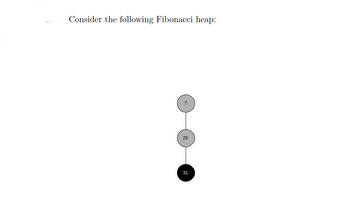Question
Use the given Fibonacci heap in the figure and solve the following question.
It’s a heap with a single tree. Only the node with value 31 is marked. Give a sequence of
legal Fibonacci heap operations that could have created this tree starting from the empty
heap.

Transcribed Image Text:Consider the following Fibonacci heap:
25
31
Expert Solution
This question has been solved!
Explore an expertly crafted, step-by-step solution for a thorough understanding of key concepts.
Step by stepSolved in 3 steps

Knowledge Booster
Similar questions
- Let's assume that a binary heap is represented using a binary tree such that each node may have a left child node and a right child node. For this type of representation, we can still label the nodes of the tree in the same way as we label the nodes for an array representation. That is, the root node has a label 1. In general, for a node with label i, its left child node will have a label 2i and the right child has a label 2i+1. For any i with 1 <= I <= n , Terry says that the following easy algorithm will walk you from the root node to the node with label i: First find the binary representation P of i. Start with the rightmost bit (least significant bit) of P, walk down from the root as follow: For a 0 bit, walk to the left child, for a 1 bit walk to the right child. At the end, you’ll reach the node with label i. Which of the following is the most appropriate? A. Terry’s algorithm is wrong and not fixable. B. Terry’s algorithm is right. C. Terry's algorithm can be…arrow_forwardSuppose we have an ArrayHeap that uses the array representation from class (also called "tree representation 3B" in lecture). Recall that in this representation that the leftmost item is unused. Consider a heap with the following underlying array: | •| | 2|•| • | •| | -8 5 1 10 | 10 | 12 --- Suppose we are using our heap to represent a priority queue. If we call removeSmallest on the heap above, where will the 12 end up after removeSmallest has completed execution? Assume removeSmallest works as described in the lecture. By "completed execution", we mean the entire operation is done and the array again obeys our heap properties. O 12 will not move. O 12 will not be present in the heap. O In the root position previously occupied by a -8. O In a position previously occupied by a 5. O In a position previously occupied by a -2. O In a position previously occupied by a 9. O In a position previously occupied by a 8. O In a position previously occupied by a 0. O In a position previously…arrow_forwardYou are given a list of numbers for which you need to construct a min-heap. (A min-heap is a complete binary tree in which every key is less than or equal to the keys in its children.) How would you use an algorithm for constructing a max-heap (a heap as defined in Section 6.4) to construct a min-heap? You need to describe your algorithm in pseudo code.arrow_forward
- Given a heap with more than ten nodes, which of the following statements is wrong? O a. None of the other answers O b. The heap could be a binary search tree. O. The heap could be a full binary tree. O d. The heap could be a complete binary tree. Which of the following related to a completed graph is correct? O a. All of the other answers O b. There exists a path between each pair of nodes in a spanning tree of the graph. O. There exists a cycle between each pair of nodes in a spanning tree of the graph. O d. There exists an edge between each pair of nodes in a spanning tree of the graph.arrow_forwardTurn the following array-based binary tree into a max-heap. Show your work step by step. You will not need all the columns; Use null to fill the unneeded spaces. Use scratch paper to draw the trees at each step. 38 18 24 52 43 34 26arrow_forwardSuppose we have an ArrayHeap that uses the array representation from class (also called "tree representation 3B" in lecture). Recall that in this representation that the leftmost item is unused. Consider a heap with the following underlying array: -8 -2 9. 1 10 10 12 Suppose we perform an in-order traversal of the heap represented by this array. What will be the last value in the in-order traversal? O -8 O 5 O-2 O 9 O 8 O 1 O 10 O 12arrow_forward
arrow_back_ios
arrow_forward_ios